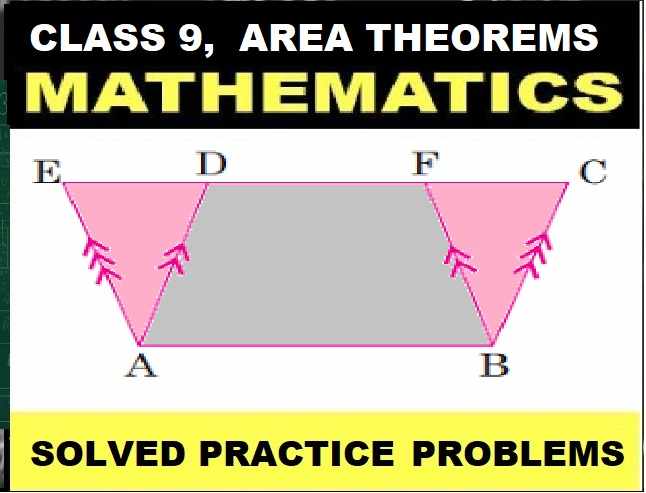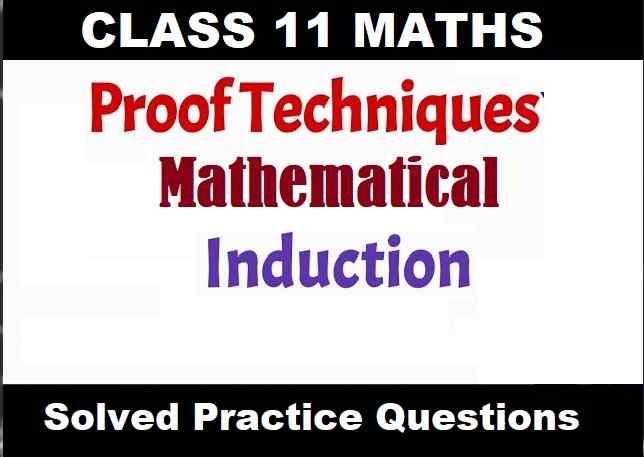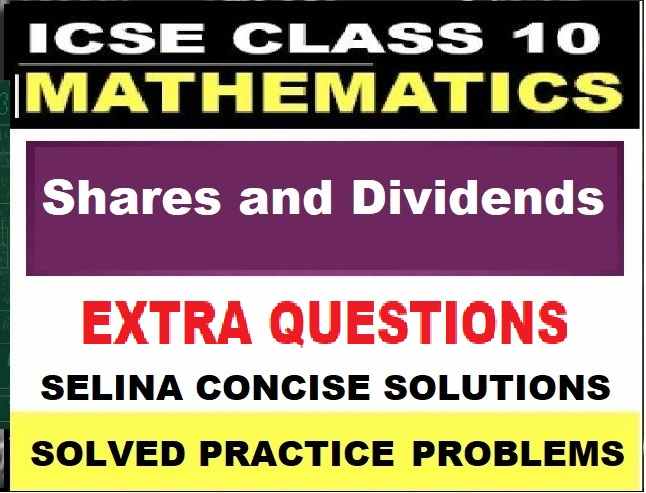ML Aggarwal Section Formula Chapter-Test Solutions ICSE Class-10 Maths Ch-11. We Provide Step by Step Answer of Exercise-11 Section Formula Chapter-Test Questions. Visit official Website CISCE for detail information about ICSE Board Class-10.
ML Aggarwal Section Formula Chapter-Test Solutions ICSE Class-10 Maths Ch-11
| Board | ICSE |
| Publications | Avichal Publishig Company (APC) |
| Subject | Maths |
| Class | 10th |
| Chapter-11 | Section Formula |
| Writer | ML Aggarwal |
| Book Name | Understanding |
| Topics | Solution of Chapter Test Questions |
| Edition | 2022-2023 |
ML Aggarwal Section Formula Chapter-Test Solutions ICSE Class-10 Maths Ch-11
Page-225
Question-1 The base BC of an equilateral triangle ABC lies on y-axis. The coordinates of the point C are (0, – 3). If origin is the mid-point of the base BC, find the coordinates of the points A and B
Answer- 1
Base BC of an equilateral ∆ABC lies on y-axis
co-ordinates of point C are (0, – 3),
origin (0, 0) is the mid-point of BC.
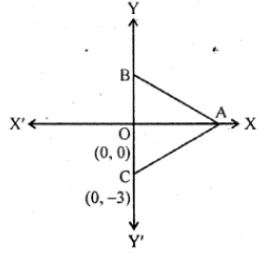
Let co-ordinates of B be (x, y)
∴ 0 = (x + 0)/2
⇒ x/2 = 0
⇒ x = 0
(y – 3)/2 = 0
⇒ y – 3 = 0
⇒ y = 3
∴ Co-ordinates of B are (0, 3)
Again let co-ordinates of A be (x, 0) as it lies on x-axis.
∵ AB = AC = BC = 6 units
![]()
x2 + (- 3)2 = 62
x2 + 9 = 36
⇒ x2 = 36 – 9 = 27
⇒ x = ± 3√3
∴ Co-ordinates of A will be (±3√3, 0)
Question -2 Find the co-ordinates of the point that divides the line segment joining the points P (5, – 2) and Q (9, 6) internally in the ratio of 3 : 1.
Answer -2
Let R be the point whose co-ordinates are (x, y)
which divides PQ in the ratio of 3:1.
∴ x = (m1x2 + m2x1)/(m1 + m2)
= (3×9 + 1×5)/(3 + 1)
= (27+5) / 4, = 32/4, = 8
y = (m1y2 + m2y1)/(m1 + m2)
= {3×6 + 1×(-2)}/(3+1)
= (18–2) / 4
= 16/4, = 4
∴ Co-ordinates of R will be (8, 4)
Question -3 Find the coordinates of the point P which is three-fourth of the way from A (3, 1) to B ( – 2, 5).
Answer-3
Co-ordinates of A (3, 1) and B ( – 2, 5)
P lies on AB such that
AP = 3/4 AB = 3/4 (AP + PB)
⇒ AP = 3PB
⇒ AP : PB = 3 : 1
Let co-ordinates of P be (x, y)
∴ x = (mx2 + nx1)/(m + n) = {(3 × (-2) + 1 × 3}/(3 + 1)
= (-6 + 3)/4
= -3/4
y = (my2 + ny1)/(m + n)
= (3×5 + 1×1)/(3+1)
= (15+1) / 4
= 16/4, = 4
∴ Co-ordinates of Pare (-3/4, 4)
Question -4 P and Q are the points on the line segment joining the points A (3, – 1) and B ( – 6, 5) such that AP = PQ = QB. Find the co-ordinates of P and Q.
Answer-4
Given

AP = PQ = QB
∴ P divides AB in the ratio of 1 : 2 and Q divides it in 2 : 1.
Let co-ordinates of P will be (x1, y1) and of Q will (x2, y2)
∴ x1 = (m1x2 + m2x1)/(m1 + m2)
= {1×(-6) + 2×3}/(1+2)
= (- 6 + 6)/3
= 0/3
= 0
y1 = (m1y2 + m2y1)/(m1 + m2)
= {1×5 + 2(-1)}/(1+2)
= (5-2)/3
= 3/3 = 1
∴ Co-ordinates of P will be (0, 1)
Again
x2 = (m1x2 + m2x1)/(m1 + m2)
= {2×(-6) + 1×3}/(2+1)
= (-12+3)/3
= -9/3, = – 3
y2 = (m1y2 + m2y1)/(m1 + m2)
= {2×5 + 1×(-1)}/(2+1)
= (10–1)/3
= 9/3 , = 3
∴ Co-ordinates of Q will be (-3, 3).
Question-5 The centre of a circle is (α + 2, α – 5). Find the value of a given that the circle passes through the points (2, – 2) and (8, – 2).
Answer -5
Let A (2, -2), B (8, -2) and centre of the circle be
O (α + 2, α – 5)
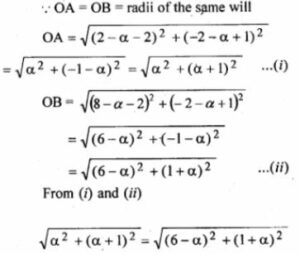
Squaring both sides,
𝝰2 + (𝝰 + 1)2 = (6 – 𝝰)2 = (1 + a)2
⇒ a2 = (6 – 𝝰)2 [dividing by (𝝰 + 1)2]
⇒ 𝝰2 = 36 – 12𝝰 + 𝝰2
= 𝝰2 – 𝝰2 + 12𝝰
= 36
⇒ 12𝝰 = 36
∴ = 36/12 = 3
ML Aggarwal Section Formula Chapter-Test Solutions ICSE Class-10 Maths
Question -6 The mid-point of the line joining A (2, p) and B (q, 4) is (3, 5). Calculate the numerical values of p and q.
Answer -6
Given
(3, 5) is the mid-point of A (2, p) and B (q, 4)
∴ 3 = (2 + q)/2
⇒ 2 + q = 6
⇒ q = 6 – 2 = 4
∴ q = 4
And 5 = (p + 4)/2
⇒ p + 4 = 10
⇒ p = 10 – 4 = 6
∴ p = 6
Hence,
p = 6, q = 4
Question-7 The ends of a diameter of a circle have the co-ordinates (3, 0) and ( – 5, 6). PQ is another diameter where Q has the coordinates ( – 1, – 2). Find the co-ordinates of P and the radius of the circle.
Answer -7
Let AB be the diameter where co-ordinates of
A are (3, 0) and of B are (-5, 6).
Co-ordinates of its origin O will be
{(3 – 5)/2, (0 + 6)/2} or (-2/2, 6/2) or (- 1, 3)
Now PQ is another diameter in which co-ordinates of Q are (-1, -2).
Let co-ordinates of P be (x, y)
Then co-ordinates of center O will be {(- 1 + x)/2, (-2 + y)/2}
∴ (-1+x)/2 = – 1
⇒ – 1+x = – 2
⇒ x = -2 + 1 = – 1
And (- 2 + y)/2 = 3
⇒ – 2 + y = 6
⇒ y = 6 + 2 = 8
∴ Co-ordinates of P will be (-1, 8)
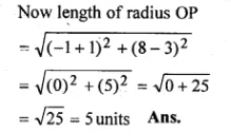
Question -8 In what ratio does the point ( – 4, 6) divide the line segment joining the points A( – 6, 10) and B (3, – 8) ?
Answer -8
Let the point (-4, 6) divides the line segment joining the points
A (-6, 10) and B (3, -8), in the ratio m : n
∴ – 4 = (mx2 + nx1)/(m + n) = {m × 3 + n(-6)}/(m + n)
– 4 = (3m – 6n)/(m + n)
⇒ – 4m – 4n = 3m – 6n
⇒ – 4n + 6n = 3m + 4m
⇒ 7m = 2n
⇒ m/n = 2/7
∴ Ratio = 2 : 7
Question -9 Find the ratio in which the point P ( – 3, p) divides the line segment joining the points ( – 5, – 4) and ( – 2, 3). Hence find the value of p.
Answer -9
Let P (-3, p) divides AB in the ratio of m1 : m2 coordinates of
A (-5, -4) and B (-2, 3)
∴ – 3 = (m1x2 + m2x1)/(m1 + m2)
⇒ – 3 {m1(-2) + m2(-5)}/(m1 + m2)
⇒ – 3 = (- 2m1 – 5m2)/(m1 + m2)
⇒ – 3m1 – 3m2 = – 2m1 – 5m2
⇒ – 3m1 + 2m1 = – 5m2 + 3m2
⇒ – m1 = – 2m2
⇒ 2m2 = m1
⇒ m1/m2 = 2/1
⇒ m1: m2 = 2 : 1
Again,
p = (m1y2 + m2y1)/(m1 + m2)
= {(2×3 + 1×(-4)}/(2 + 1)
= (6 – 4)/3
= 2/3
Hence,
p = 2/3
Question -10 In what ratio is the line joining the points (4, 2) and (3, – 5) divided by the x-axis? Also find the co-ordinates of the point of division.
Answer-10
Let the point P which is on the x-axis, divides the line segment
joining the points A (4, 2) and B (3, -5) in the ratio of m1 : m2.
and let co-ordinates of P be (x, 0)
∴ 0 = (m1y2 + m2y1)/(m1 + m2)
= {m1(-5) + m2(2)}/(m1 + m2)
⇒ (- 5m1 + 2m2)/(m1 + m2) = 0
⇒ – 5m1 + 2m2 = 0
⇒ – 5m1 = – 2m2
⇒ 5m1 = 2m2
⇒ m1/m2 = 2/5
⇒ m1 : m2 = 2 : 5
x = (m1x2 + m2x1)/(m1 + m2)
= {2×3 + 5×4}/(2+5)
= (6 + 20)/7
= 26/7
∴ Co-ordinates of P will be (26/7, 0)
ML Aggarwal Section Formula Chapter-Test Solutions ICSE Class-10 Maths
Question -11 If the abscissa of a point P is 2, find the ratio in which it divides the line segment joining the points ( – 4 – 3) and (6, 3). Hence, find the co-ordinates of P.
Answer -11
Let co-ordinates of A be (-4, 3) and of B (6, 3) and of P be (2, y)
Let the ratio in which the P divides AB be m1 : m2
![]()
∵ x = (m1x2 + m2x1)/(m1 + m2)
⇒ 2 = (m1×6 + m2×(-4)}/(m1+m2)
⇒ 2 = (6m1 – 4m2)/(m1 + m2)
⇒ 2m1 + 2m2 = 6m1 – 4m2
⇒ 6m1 – 2m1 = 2m2 + 4m2
⇒ 4m1 = 6m2
⇒ m1/m2 = 6/4 = 3/2
∴ m1 : m2 = 3 : 2
∴ y = (m1y2 + m2y1)/(m1+m2)
= (3×3 + 2×3)/(3+2)
= (9 + 6)/5
= 15/5
= 3
∴ Co-ordinates of P will be (-2, 3)
Question- 12 Determine the ratio in which the line 2x + y – 4 = 0 divide the line segment joining the points A (2, – 2) and B (3, 7). Also find the co-ordinates of the point of division.
Answer -12
Points are given A (2, -2), B (3, 7)
and let the line 2x + y – 4 = 0 divides AB in the ratio m1 : m2
at P and let co-ordinates of
x = (m1x2 + m2x1)/(m1 + m2)
= (m1×3 + m2×2 )/ (m1 + m2)
= (3m1 + 2m2)/(m1 + m2)
And y = {m1×7 + m2×(-2)}/(m1+m2)
= {7m1 – 2m2}/(m1+m2)
∴ P lies on the line 2x + y – 4 = 0, then
2(3m1 + 2m2)/(m1+m2) + (7m1 – 2m2)/(m1+m2) – 4 = 0
⇒ 6m1 + 4m2 + 7m1 – 2m2 – 4m1 – 4m2 = 0
⇒ 9m1 – 2m2 = 0
⇒ 9m1 = 2m2
⇒ m1/m2 = 2/9
or m1 : m2 = 2 : 9
∴ x = (2×3 + 2×9)/(2 + 9)
= (6 + 18)/11
= 24/11
And y = (2 × 7 – 2 × 9)/(2 + 9)
= (14 – 18)/11
= -4/11
∴ Co-ordinates of P will be (24/11, -4/11)
Question -13 ABCD is a parallelogram. If the coordinates of A, B and D are (10, – 6), (2, – 6) and (4, – 2) respectively, find the co-ordinates of C.
Answer-13
Let the co-ordinates of C be (x, y) and other three vertices
of the given parallelogram are A (10, – 6), B, (2, – 6) and D (4, – 2)
∴ ABCD is a parallelogram
Its diagonals bisect each other.
Let AC and BD intersect each other at O.
∴O is mid-points of BD
∴ Co-ordinates of O will be
{(2+4)/2, (-6–2)/2) or (6/2, -8/2) or (3, -4)
Again, O is the mid-point of AC then
3 = (10 + x)/2
⇒ 10 + x = 6
⇒ x = 6 – 10 = – 4
And – 4 = (-6 + y)/2
⇒ 6 + y = – 8
⇒ – 8 + 6
∴ y = – 2
Hence Co-ordinates of C will be (- 4, – 2).
Section Formula Chapter-Test
ML Aggarwal Solutions ICSE Class-10 Maths
Page-226
Question -14
ABCD is a parallelogram whose vertices A and B have co-ordinates (2, – 3) and ( – 1, – 1) respectively. If the diagonals of the parallelogram meet at the point M(1, – 4), find the co-ordinates of C and D. Hence, find the perimeter of the parallelogram. find the perimeter of the parallelogram.
Answer -14
ABCD is a || gm , m which co-ordinates of A are (2, -3) and B (-1, -1)
Its diagonals AC and BD bisect each other at M (1, -4)
∴ M is the midpoint of AC and BD
Let co-ordinates of C be (x1, y1) and of D be (x2, y2)
when M is the midpoint of AC then
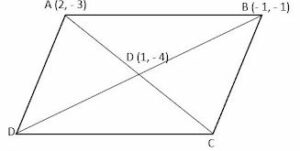
∴ l = (2 + x1)/2 and – 4 = (-3 + y1)/2
⇒ 2 + x1 = 2
⇒ x1 = 2 – 2 = 0
And –8 = -3 + y1
⇒ y1 = -8 + 3 = -5
∴ Co-ordinates of C are (0, -5)
Again M is mid-point of BD, then
1 = (-1 + x2)/2, -4 = (-1 + y2)/2
⇒ -1 + x2 = 2
⇒ x2 = 2 + 1 = 3
And –1 + y2 = -8
⇒ y2 = -8 + 1 = -7
∴ Co-ordinates of D are (3, -7)
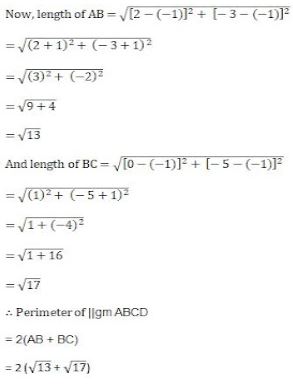
Question -15 Given, O, (0, 0), P(1, 2), S( – 3, 0) P divides OQ in the ratio of 2 : 3 and OPRS is a parallelogram.
Find :
(i) the co-ordinates of Q.
(ii)the co-ordinates of R.
(iii) the ratio in which RQ is divided by y-axis.
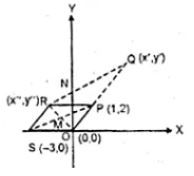
Answer -15
(i) Let co-ordinates of Q be (x’, y’) and of R (x”, y”) Point P (1, 2) divides OQ in the ratio of 2 : 3
∴ l = (m1x2 + m2x1)/(m1 + m2)
= (2x’ + 3×0)/(2+3)
⇒ (2x’+0)/5 = 1
⇒ 2x’ = 5
⇒ x’ = 5/2
And 2 = (m1y2 + m2y1)/(m1+m2)
= (2y’ + 3×0)/(2+3)
⇒ 2y’/5 = 2
⇒ 2y’ = 10
⇒ y’ = 5
∴ Co-ordinates of Q will be (5/2, 5)
∵ the diagonals of a parallelogram bisect each other
∴ In ||gm OPRS, diagonals OR and PS bisect each other at M.
∵ M is the mid-point of PS
∴ Co-ordinates of M will be = {(-2+1)/2, (0+2)/2}
or (-2/2, 2/2)
or (-1, 1)
(ii) ∵ M is the mid-point of OR also
∴ – 1 = (0 + x’’)/2
⇒ x’’ = – 2
And 1 = (0 + y’’)/2
⇒ y’’ = – 2
∴ Co-ordinates of R will be (- 2, 2)
(iii) RQ is dividing by y-axis in N
Let the ratio in which N divides RQ in m1 : m2
∵ N lies on y-axis
∴ its abscissa (x) = 0
0 = (m2x’ + m2x”)/(m1 + m2)
⇒ 0 = {m1×5/2 + m2×(-2)}/(m1+m2)
⇒ (5m1/2 – 2m2)/(m1+m2) = 0
⇒ 5/2 m1 – 2m2 = 0
⇒ 5/2 m1 = 2m2
⇒ m1/m2 = (2×2)/5 = 4/5
∴ m1 : m2 = 4 : 5
Question -16 If A (5, – 1), B ( – 3, – 2) and C ( – 1, 8) are the vertices of a triangle ABC, find the length of the median through A and the co-ordinates of the centroid of triangle ABC.
Answer -16
A (5, -1), B (-3, -2) and C (-1, 8) are the vertices of ∆ABC
D, E and F are the midpoints of sides BC, CA and AB respectively
and G is the centroid of the ∆ABC
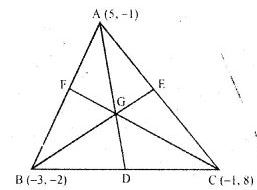
∵ D is the midpoint of BC
∴ Co-ordinates of D will be {(x1 + x2)/2}, (y1 + y2)/2} or {(-3 –1)/2 , (-2+8)/2} or (-4/2, 6/2) or (-2, 3)
∵ G is the centroid
∴ Co-ordinates of G will be {(x1 + x2 + x3)/3 , (y1 + y2 + y3)/3}
Or {(5 – 3 – 1)/3, (-1–2 + 8)/3} or (1/3, 5/3)
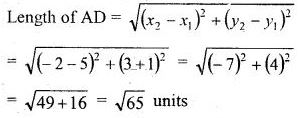
–: ML Aggarwal Section Formula Chapter-Test Solutions ICSE Class-10 Maths:–
